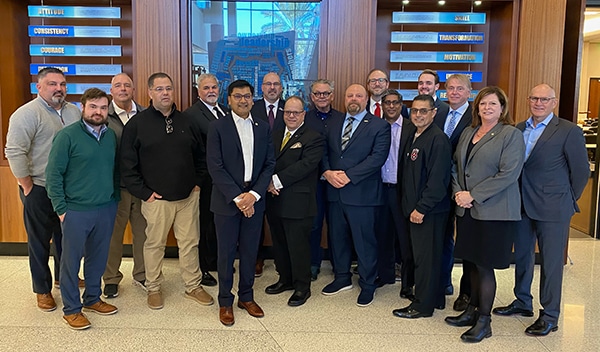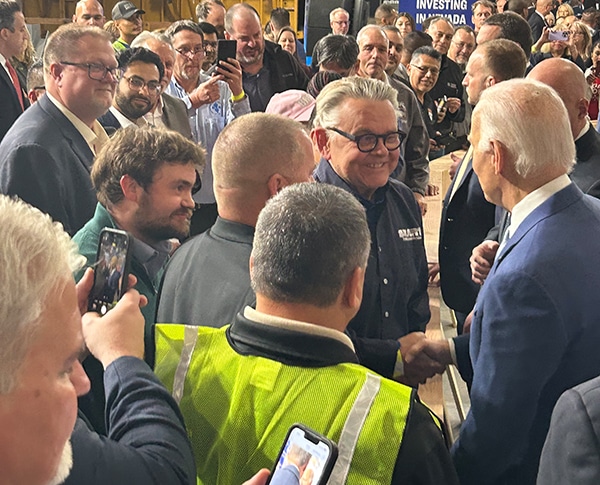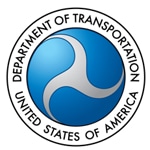On December 8, 2023, United States President Joe Biden and SMART-TD President Jeremy Ferguson announced a $6 billion investment in America’s rail infrastructure and in the value of union jobs through two high-speed rail projects in California and Nevada.
“When I ran for president, I made a commitment to build a high-speed rail worthy of America. I mean it — put our nation on track with the fastest, safest and greenest railways in the world, and high-speed,” President Biden said during an announcement event in Las Vegas, Nevada. “You have no idea how much this pleases me: At long last, we are building the first high-speed rail project in our nation’s history, and it’s starting here.
“It means growth and opportunity for towns and communities between here and the California coast. It’s on track to be completed by the 2028 Olympics in Los Angeles. And here’s the best part — it means jobs. Union jobs, jobs, jobs, jobs!”
“The idea of high-speed rail has been discussed in this country for decades, and it is beyond exciting to see it coming together here today,” Ferguson added. “Our members, and our brothers and sisters throughout rail labor, should see this as a day when our nation’s president and the country itself recognized our value and what we bring to the table. The skills our conductors, engineers and yardmasters possess were not an afterthought when the plans for this rail line came together. They are invaluable to this project and woven into the fabric of what will make this high-speed rail project a success.”

This project has been years in the making and is becoming a reality now due to the public-private partnership between the federal government and the Brightline West Railroad. In plans submitted to the administration, Brightline highlighted the efficiency of this high-speed rail project, stating that trains will travel at speeds upwards of 186 mph – making it possible to get from Southern California to Las Vegas in just over two hours, a fraction of the time it takes on the highway. Other benefits include taking traffic off the heavily congested U.S. Interstate 15, as well as positive impacts on environmental emissions. This project will also bolster the economies of some of our nation’s largest cities.
As a stipulation for receiving federal funding, Brightline West committed to using an organized workforce. SMART-TD has been part of the planning for this project since the railroad made that commitment to Biden and Congress. Along with employing thousands of our brothers and sisters in the SMART Rail, Mechanical and Engineering Department, the Brotherhood of Maintenance of Way, Brotherhood of Railroad Signalmen, TCU and all of our rail labor partners, Brightline West also committed to running their trains with SMART-TD crews.

The project will provide hundreds of good, union jobs in the railroad industry, and it serves as an example of what can be accomplished when private industry, the federal government and a strong labor coalition are all pulling in the same direction.
“It’s a proud day for us, and we thank Congresswoman Dina Titus from Nevada’s First Congressional District, Congressman Steven Horsford from Nevada District 4, Congresswoman Susie Lee from Nevada’s Third District, and Nevada’s U.S. Senators Jacky Rosen and Catherine Cortez Masto, along with the Department of Transportation, and of course, President Joe Biden himself for all of their work to make this dream a reality for our men and women,” Ferguson concluded.
 WASHINGTON – The U.S. Department of Transportation’s (DOT) Federal Railroad Administration (FRA) issued a final rule establishing modern, performance-based safety standards for railroad passenger equipment. The rule reinforces FRA’s commitment to safety while representing one of the most significant enhancements to the nation’s passenger rail design standards in a century. The rule paves the way for U.S. high-speed passenger trains to safely travel as fast as 220 miles per hour (mph).
WASHINGTON – The U.S. Department of Transportation’s (DOT) Federal Railroad Administration (FRA) issued a final rule establishing modern, performance-based safety standards for railroad passenger equipment. The rule reinforces FRA’s commitment to safety while representing one of the most significant enhancements to the nation’s passenger rail design standards in a century. The rule paves the way for U.S. high-speed passenger trains to safely travel as fast as 220 miles per hour (mph).
 WASHINGTON – Amtrak is contracting with Alstom to produce 28 next-generation high-speed trainsets that will replace the equipment used to provide Amtrak’s premium Acela Express service. The contract is part of $2.45 billion that will be invested on the heavily traveled Northeast Corridor (NEC) as part of a multifaceted modernization program to renew and expand the Acela Express service.
WASHINGTON – Amtrak is contracting with Alstom to produce 28 next-generation high-speed trainsets that will replace the equipment used to provide Amtrak’s premium Acela Express service. The contract is part of $2.45 billion that will be invested on the heavily traveled Northeast Corridor (NEC) as part of a multifaceted modernization program to renew and expand the Acela Express service. Around the globe, the race is on to bring the world’s fastest trains — which top speeds nearing 400 miles per hour — to commuters, travelers and business professionals alike. China is devoting billions with hopes for leading the world in rail innovation. Japan is continually making improvements to its 50-year-old system. Countries throughout Europe are expanding upon thousands of miles of high-speed rail track, which run from the south of Spain to Berlin, Oslo and Edinburgh. Meanwhile, the U.S., once known for its transportation innovations, is struggling to catch up.
Around the globe, the race is on to bring the world’s fastest trains — which top speeds nearing 400 miles per hour — to commuters, travelers and business professionals alike. China is devoting billions with hopes for leading the world in rail innovation. Japan is continually making improvements to its 50-year-old system. Countries throughout Europe are expanding upon thousands of miles of high-speed rail track, which run from the south of Spain to Berlin, Oslo and Edinburgh. Meanwhile, the U.S., once known for its transportation innovations, is struggling to catch up. Washington – The U.S. Department of Transportation (DOT)’s Federal Railroad Administration (FRA), the State of North Carolina and the Commonwealth of Virginia announced today that they have signed off on the Final Environmental Impact Statement (FEIS) for the proposed Richmond to Raleigh (R2R) passenger rail line along the Southeast Corridor. The completion of the FEIS is one of the final steps necessary before construction of the project can move forward once funding is secured.
Washington – The U.S. Department of Transportation (DOT)’s Federal Railroad Administration (FRA), the State of North Carolina and the Commonwealth of Virginia announced today that they have signed off on the Final Environmental Impact Statement (FEIS) for the proposed Richmond to Raleigh (R2R) passenger rail line along the Southeast Corridor. The completion of the FEIS is one of the final steps necessary before construction of the project can move forward once funding is secured.